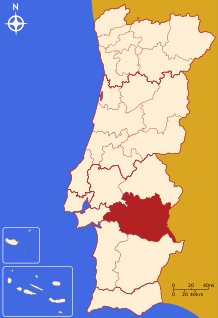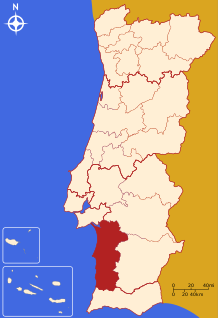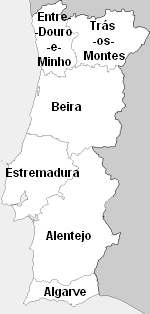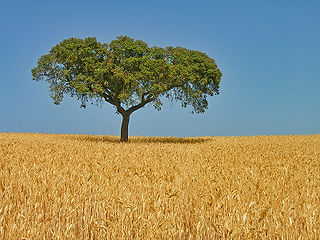 W
WThe Alentejo is a geographical, historical and cultural region of south central and southern Portugal. In Portuguese, its name means "beyond the Tagus river" (Tejo).
 W
W W
WThe Comunidade Intermunicipal do Alentejo Central is an administrative division in Portugal. It was created in 2009. The seat of the intermunicipal community is Évora, the main city. Other cities are Estremoz, Montemor-o-Novo, Vendas Novas and Reguengos de Monsaraz. Alentejo Central is coterminous with the former Évora District. The population in 2011 was 166,726, in an area of 7,393.46 km².
 W
WThe Comunidade Intermunicipal do Alentejo Litoral is an administrative division in Portugal. It was created in May 2009. It is also a NUTS3 subregion of the Alentejo Region. The seat of the intermunicipal community is Grândola. Alentejo Litoral comprises municipalities of both the Beja District and the Setúbal District. The population in 2011 was 97,925, in an area of 5,309.41 km².
 W
WAlentejo Province is one of the six historical provinces of Portugal. The province took its name from the Portuguese além Tejo, meaning "Beyond the (River) Tagus". It covers the historical and cultural region Alentejo. It was created in 1832, and was divided into Alto Alentejo Province and Baixo Alentejo Province in 1933.
 W
WAlentejo Region is one of the seven NUTS 2 regions of Portugal. It covers all of the historical Alentejo Province and part of the historical Ribatejo and Estremadura provinces.
 W
WAlto Alentejo was a Portuguese province. It was abolished with the Constitution of 1976.
 W
WBaixo Alentejo was a Portuguese province. It was abolished with the Constitution of 1976.
 W
WCante Alentejano is a Portuguese music genre based on vocal music without instrumentation from the Alentejo region. It was inscribed in 2014 in UNESCO's Representative List of the Intangible Cultural Heritage of Humanity, one of two Portuguese music traditions, the other being Fado. Its origins come from a similar popular music genre created in the region of Minde by campinos. It is said that the habit of singing without instruments was common in bullherding as a means to coordinate efforts among the campinos.
 W
WThe Church of Porto Covo is Baroque and Neoclassic church in the civil parish, municipality of Sines, in the Atlantic coast of the Portuguese Alentejo. The church's austere lines is a morphological hybridization of the styles employed during the reign of Queen Maria I. In the widespread typology of regional architecture, the Baroque elements are evident in the lintels and trim curves, framed in a composition that is, generally, more rigid then in the gable design.
 W
WGuadiana Valley Natural Park is a natural park in southeastern Portugal. It is one of the 30 areas which are officially under protection in the country.
 W
WEvoramonte, or Évora-monte, is a civil parish in the municipality of Estremoz in the Alentejo Central subregion of Portugal. The population in 2011 was 569, in an area of 99.38 km².
 W
WThe Comunidade Intermunicipal da Lezíria do Tejo is an administrative division in Portugal. It was established as an Associação de Municípios in 1987, converted into a Comunidade Urbana in 2003, and converted into a Comunidade Intermunicipal in November 2008. It is also a NUTS3 subregion of the Alentejo Region. The seat of the intermunicipal community is the city of Santarém. Lezíria do Tejo comprises municipalities of the former districts of Santarém and Lisbon. The population in 2011 was 247,453, in an area of 4,275 square kilometres (1,651 sq mi). In the past, the territory of this administrative division was roughly entirely set in the former historical province of Ribatejo and had nothing to do with the former historical province of Alentejo. Lezíria is the Portuguese word for floodplain or freshwater marsh. Tejo is the name of the main river in the region. The Lezíria is a well-renowned center of intensive farming, horse breeding and animal husbandry.
 W
WSanto André and Sancha Lagoons Natural Reserve is a natural reserve in Portugal. It is one of the 30 areas which are officially under protection in the country.
 W
WSerra de São Mamede Natural Park is a natural park in the Serra de São Mamede range, Portugal. It is one of the 30 areas which are officially under protection in the country.
 W
WSouthwest Alentejo and Vicentine Coast Natural Park (PNSACV) is a natural park located in southwest Portugal. It occupies an area of 895.7 km2 (345.8 sq mi) and is one of the last strongholds of the wild European coast. It has one of the highest levels of biodiversity in the country with over 12 endemic species of plant and several bird nesting sites.